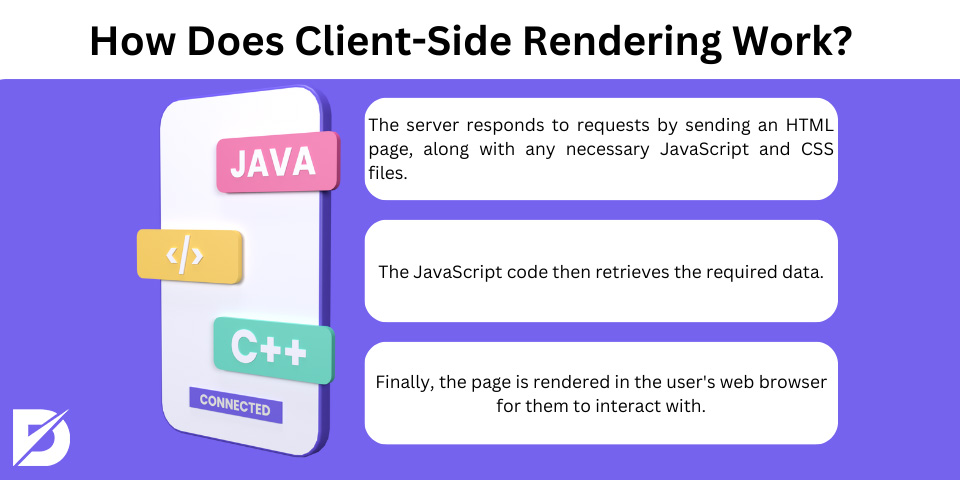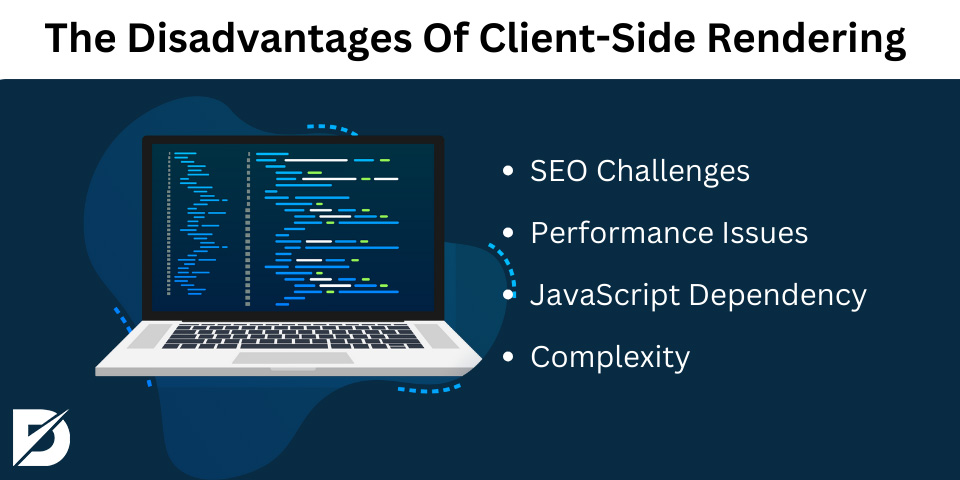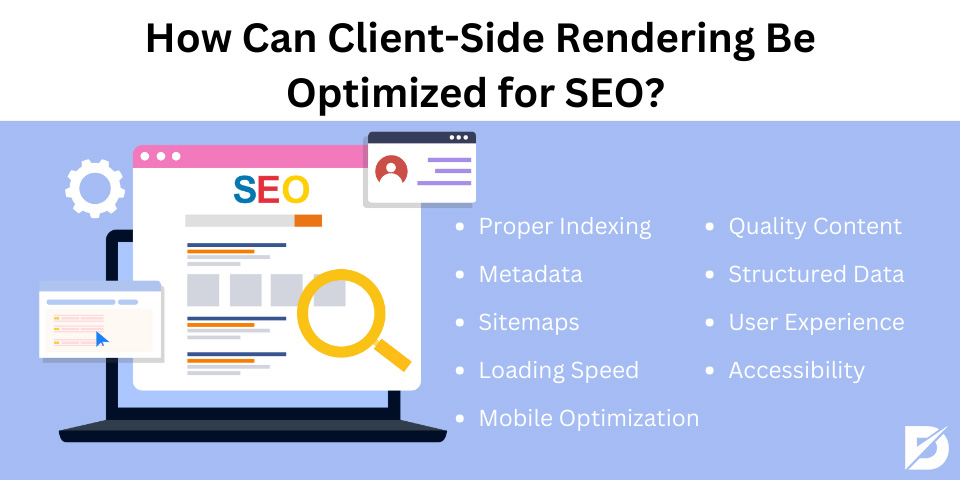Fast webpage loading is important for how users feel and for SEO, as Google pays attention to how quickly pages load. Web developers have to choose how to make a website that’s both quick and shows changing content. Two common ways are client-side rendering (CSR) and server-side rendering (SSR). Because every website is different, knowing the contrast between client-side and server-side rendering can help you make your website fit your business needs. Now, let’s read more about the title in the article step by step.
What Is Client-Side Rendering?
In traditional server-side rendering (SSR), the server creates the webpage and sends it to your computer. In client-side rendering (CSR), the webpage is created on your computer using JavaScript. With CSR, your computer asks the server for a simple webpage with a special computer code. When your computer gets the code, it uses it to display the webpage. This way, you can see and use the webpage, but your computer has to do more work before it appears.
How Does Client-Side Rendering Work?
Server-side rendering is a common way to show information on your screen. It works by changing HTML files on the server into things your browser can use. When you go to a website, your browser asks the server for the website’s stuff. This request is usually quick, but it depends on things like your internet speed, where the server is, how many people want to see the site, and how well the website is made.
Client-side rendering operates by using JavaScript to dynamically create and change the HTML and CSS on a page. This new HTML and CSS is then put on the page, making it dynamic and able to interact with the user. Let’s look at smaller steps:

- A user asks the server for a page. This can be done by directly requesting the server or by clicking a link that causes a request.
- The server sends a basic HTML page to the user, usually with a loading image or something similar to show something happening behind the scenes.
- Along with that initial HTML, the server also sends any necessary JavaScript and CSS files. The user’s web browser loads the HTML page and runs the JavaScript code.
- The JavaScript code asks for data from an API or another place where data is stored to get what’s needed for the page.
- When the data is received, the JavaScript code uses it to show the page in the web browser. Now, the page is fully loaded and visible, and you can interact with it.
The Advantages Of Client-Side Rendering
Client-side rendering (CSR) generates HTML on-demand and doesn’t refresh or re-render the entire page like regular HTML pages. It appears as if each click or interaction is loading a new page, but in reality, it’s rendering the content on the same page. This conserves computational power and RAM, resulting in faster outcomes compared to server-side rendering (SSR).
The advantages of client-side rendering are listed below:
- Improved User Experience: Client-side rendering enhances the user experience by creating dynamic and interactive web pages that respond quickly to user actions. This results in a more engaging and satisfying experience for website visitors.
- Faster Page Loads: With client-side rendering, the client only requests a basic HTML file from the server, which includes the necessary JavaScript and CSS files. As a result, web pages can load more quickly. This is especially valuable for mobile users who might have limited internet speed.
- Easier to Scale: Client-side rendering is often easier to scale compared to server-side rendering. In server-side rendering, the server needs to generate HTML for each page request, which can be resource-intensive. In contrast, client-side rendering shifts the rendering work to the user’s device, making it beneficial for high-traffic websites that need to handle numerous user requests.
- Separation of Concerns: Client-side rendering promotes a separation of concerns between front-end and back-end development teams. The back-end team can focus on building the API or managing the database, while the front-end team concentrates on creating the user interface. This separation allows for more efficient collaboration and specialization in different aspects of web development.
The Disadvantages Of Client-Side Rendering
The entire JavaScript code is loaded the first time a user visits a web page. Afterward, it makes API calls to fetch data from the database and uses this data to generate the HTML content dynamically in the browser.
However, the initial data loading during the first visit can take a bit longer than server-side rendering (SSR), where the server generates the HTML with data before sending it to the client. This is because client-side rendering requires an additional step to fetch and process data in the client’s browser, which may introduce some delay during the initial page load.
The disadvantages of client-side rendering are listed below:

- SEO Challenges: Search engine crawlers may struggle to crawl and index client-side rendered content, potentially leading to SEO issues as the content may not be effectively ranked in search results.
- Performance Issues: CSR can result in performance problems, especially on slower devices or when dealing with substantial amounts of data. This can lead to slower page load times and a less responsive user interface.
- JavaScript Dependency: CSR relies on JavaScript to function, which can be a limitation for users with older browsers or those who require accessibility features that might not work well with JavaScript-dependent websites.
- Complexity: Implementing client-side rendering can be more complex compared to server-side rendering. It often requires a deeper understanding of JavaScript and front-end frameworks, making development more intricate and potentially demanding a higher level of expertise.
What Are The Differences Between Client-Side And Server-Side Rendering?
The main difference between these two rendering methods is how they work. Client-side rendering (CSR) shows an empty page at the beginning, while server-side rendering (SSR) displays a complete HTML page right away. SSR has a speed advantage because it doesn’t need the browser to process big JavaScript files. Content becomes visible very quickly, often within a couple of milliseconds. Search engines can easily read the site for better SEO, making it simpler to list your web pages. SSR sites look like text in the browser.
However, CSR is a more cost-effective choice for website owners. It takes the rendering task away from your servers and puts it on the client’s side, like a bot or a user who wants to see your page. It also gives a fast user experience for website interactions after the first load.
Client-side rendering makes fewer requests to the server than SSR, which generates each page from the beginning, leading to slower transitions between pages. When many users send requests at the same time, SSR can struggle with a heavy server load.
In addition, CSR takes a bit longer to load initially, affecting SEO. Web crawlers might not wait for the content to appear and might leave the site. This two-step process means there’s a chance you might see empty content on your page if the JavaScript content is missing when the page is first crawled and indexed. Remember that, in most cases, CSR requires an external library.
How Does Client-Side Rendering Impact SEO
To get a good ranking on Google, your website needs to be included in its index. To be included in the index, your website has to be properly rendered. If your content can’t be rendered, it won’t help Google understand or promote your site. SEO client-side rendering (CSR) can create challenges. Search engines rely on quick content retrieval, and they may not wait for JavaScript execution, which can result in incomplete indexing.
- Server-side rendering (SSR) addresses these challenges are listed below:
- Offering Fully Rendered Content: SSR ensures that content is fully rendered, allowing for complete indexing by search engines.
- Faster Page Loads: SSR delivers faster page loading times, a factor that search engines typically reward with higher rankings.
- Reducing SEO Pitfalls: SSR helps reduce SEO issues like “Flash of Unstyled Content” or “Flash of Invisible Text.”
SEO may seem simple, but it’s a full-time job. Search engines constantly change their methods and what they look at, and we’ve also changed how we create websites.
Additionally, SSR provides the following benefits:
- By handling page rendering at the server level, SSR lightens the load on the client’s side. This leads to quicker page loading, especially on mobile devices and older computers.
- Faster Time To First Byte (TTFB) results in quicker page display, enhancing user satisfaction and website responsiveness.
- To ensure rapid content delivery globally, SSR can utilize Content Delivery Networks (CDNs), which are server networks that distribute and deliver content from the user’s nearest server.
What Are the Benefits of Using Client-Side Rendering for SEO?
Search engines value website speed and user experience. A faster initial page load can lead to a higher ranking in search results. Some search engine tools may not even handle JavaScript, so server-side rendering (SSR) becomes essential for accurate and complete indexing. SSR also helps by reducing the amount of work the user’s browser has to do since the content is already rendered, ensuring a quicker display of the web page. This is particularly helpful for users with slower internet connections or less powerful devices.
Server-side rendering (SSR) is a powerful tool for improving your SEO performance because it allows search engines to index your pages before loading them in the browser. This not only benefits the organization building the web application but also helps track engagement metrics to continually enhance the user experience. To make it simpler, check the list below:
- Faster Page Loading
- Interactive User Experience
- Reduced Server Load
- User Retention
- Content Updates
How Does Client-Side Rendering Affect the Loading Speed of a Website?
Client-side rendering can impact loading speed by increasing the time it takes for a website to load initially. With server-side rendering, the HTML and other assets are pre-generated and can be sent to the client’s browser in a single request, resulting in faster initial loading times. However, client-side rendering requires additional time to load and process JavaScript, which can delay content display on the web page. Server-side rendered web pages can be very fast, and this largely depends on the speed of the server and the user’s internet connection. When both of these conditions are optimal, server-side rendering (SSR) can deliver excellent performance.
How Does Client-Side Rendering Impact the User Experience on a Website?
Client-side rendering can greatly affect the user experience of a website. While it can make the website more interactive and responsive, it may also lead to longer initial load times and put more strain on the client’s web browser regarding resource usage.
How Can Client-Side Rendering Be Optimized for SEO?
Client-side rendering is a good choice for websites and apps, making them load faster and providing a smoother user experience. But, it can be tricky for SEO because search engines might struggle to crawl and index the website’s content.
To see how optimizing client-side rendering for SEO are listed below:

- Proper Indexing: Ensure that search engines can index your CSR content by using techniques such as pre-rendering or dynamic rendering.
- Metadata: Utilize metadata tags like title, description, and schema markup to provide search engines with essential information about your pages, compensating for CSR’s potential indexing challenges.
- Sitemaps: Create XML sitemaps that list all your web pages to help search engines discover and index your content effectively.
- Loading Speed: Optimize the loading speed of your CSR content by minimizing the use of large JavaScript files and leveraging techniques like code splitting, lazy loading, and efficient caching.
- Mobile Optimization: Ensure your CSR content is mobile-friendly, as mobile usability is a significant factor in SEO rankings.
- Quality Content: Provide valuable and high-quality content that engages users and encourages them to stay on your site. Reducing bounce rates can positively impact SEO.
- Structured Data: Implement structured data markup to enhance the visibility of your content in search results.
- User Experience: Focus on providing a positive user experience, which can lead to higher user engagement and improved SEO performance.
- Accessibility: Ensure that your CSR content is accessible to all users, including those with disabilities, by following accessibility guidelines.
Client-side Rendering and SEO
Using client-side rendering makes web pages dynamic and fun. It’s good for users and makes pages load faster. But it also has some problems, like being hard for search engines, not working well on slow devices, and being a bit complicated. When picking between client-side rendering and other methods, think about what’s good and not, and choose what fits your project best. Client-side rendering (CSR) handles routing without refreshing the page when users go to different parts of the website, which can result in a faster first load time. On the other hand, server-side rendering (SSR) shows a complete page for any part of the website right from the start, which means a bit slower first loading but faster rendering after the initial load.
Frequently Asked Questions About
Client-side rendering is a cost-effective choice for website owners. It shifts the rendering work to the client’s side, reducing the load on your servers.
Server-side rendering is faster than client-side rendering because it involves the server rendering the page and sending the fully rendered HTML to the client.
If the HTML code includes all the content, such as the main body, images, text, and more, then the site is likely using server-side rendering (SSR).





No comments to show.